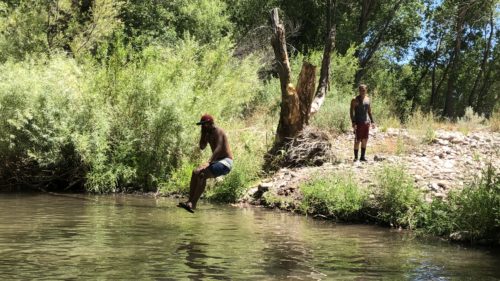It’s critical that all hunters, anglers and other public land users participate in developing pending forest management plans that will determine the future of much of New Mexico’s prime public lands.
The Cibola, Carson and Santa Fe National Forests in New Mexico all published proposed revisions to their forest land management plans on Aug. 9. All three forests are taking public comment on the plans for 90 days and each has scheduled a series of public meetings.
The Rio Grande National Forest, in southern Colorado, is further along in the process and just released its Final Draft Plan, Environmental Impact Statement and Record of Decision.
Jeremy Romero, regional connectivity coordinator with the National Wildlife Federation, has been tracking the forest plans, working with forest planners and an engaged group of stakeholders in providing comments. He said he’s been emphasizing the importance of recognizing and preserving wildlife connectivity and corridors, or longstanding migration paths, and on preserving traditional cultures of northern New Mexico and southern Colorado.
“Everything and anything that happens on the forest is managed in these plans and we want to make sure that wildlife is prioritized,” Romero said. Residents of traditional communities that depend on wildlife populations for food can’t fill the freezer if wildlife can’t continue to follow their migration corridors through the landscape, he said.
The concern about wildlife connectivity and corridors increasingly extends beyond hunting and jurisdictional boundaries, Romero said. ”For the wildlife enthusiast, if these pathways are fragmented and those connections are no longer intact, then your connection to wildlife becomes jeopardized,” he said.
Once the final forest plans are adopted, they will set the stage for how the forests will be managed for at least 10 to 15 years or longer, said Romero, who also works closely with the New Mexico Wildlife Federation. He said traditional communities that depend on the environment must let their voices be heard to ensure the forest plans represent their values and traditions.
“A lot of the habitat and environment around these communities provide an economic resource and a viability for many residents to practice the traditional way of life that goes back hundreds of years,” Romero said. “It’s a traditional way of life that involves hunting, wood gathering, and traditional land uses. These are all activities that have been happening on the forest.”
Local communities in northern New Mexico and southern Colorado depend on healthy watersheds, on healthy forests that produce clean air and on open spaces where residents are able to recreate, Romero said.
Federal rules established in 2012 spelled out the requirements of how the U.S. Forest Service must handle the forest plan revision process. Among the requirements is to make landscape and wildlife habitat connectivity a priority, Romero said.
“We know wildlife move across boundaries,” Romero said. “They know no jurisdiction. They move from state land to federal land to tribal land to private land, and everywhere in between.”
Recent monitoring work has documented that wildlife herds commonly move from their summer range in the Colorado high country south into lower lands in New Mexico during the winter through long-established wildlife corridors.
“Recognizing that we have an opportunity to protect these certain areas, we’ve advocated for what we call special management areas,” Romero said.
Through his comments, the National Wildlife Federation has called on Forest Service planners to promote, protect and prioritize habitat connectivity.
Methods to decrease habitat fragmentation include taking down unused or unwanted fencing and using more wildlife-friendly types of fencing, Romero said. He said such areas require special attention to projects that call for new road construction or other disturbances.
The New Mexico Wildlife Federation is among the groups holding a forum next week in Taos on the importance of wildlife corridors. The Upper Rio Grande Initiative’s Third Wildlife Corridor Summit will be held Tues., Aug. 20.
The summit will bring together a host of influential and informative voices to discuss wildlife corridors and connectivity in the region. Given it is considered one of the most intact landscapes in the lower 48 for wildlife connectivity, planning for the future and protecting the present day health of Upper Rio Grande ecosystem is crucial.
The initiative is excited to showcase the voices of tribal leaders, state, local and federal policymakers, as well as traditional land users, private landowners, and many more. For more information, visit Connected Corridors.
To review the draft forest plans, go to the website of the particular national forest you are interested in: Carson National Forest, Cibola National Forest, Santa Fe National Forest. Each of the forests has scheduled public meetings across their respective areas. There’s a joint presentation including officials from all three forests on Tues., Aug. 20, from 2 p.m. – 6 p.m. at Santa Fe Community College, 6401 Richards Ave., Santa Fe.



